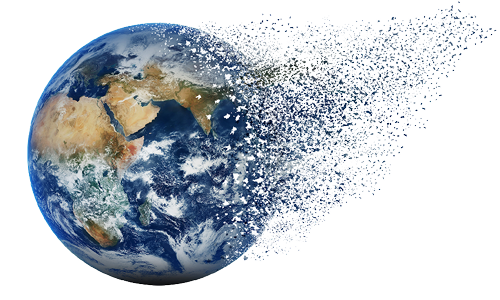Policy Brief
WIDER Annual Lecture Brief | Globalization in crisis – confronting a new economic reality
Globalization is in retreat. Trade tensions between China and the United States are escalating, as illustrated by bans to the trade of semiconductor chips. The pandemic exacerbated an already difficult economic reality, raising new concerns about the resilience of global supply chains. Further, Russia’s invasion of Ukraine brought geopolitical concerns about economic dependence on non-friendly countries to the foreground. How did we get here? And what are the potential consequences of this shift?
There is an increasing frequency of terms like ‘national security’ and ‘reshoring’ in news articles that reflect changes in trade policy attitudes and public sentiment on globalization
Globalization, represented in global trade volumes, has faced three distinct phases of setbacks since 2015, exemplified by a trade war between the US and China, Brexit, the shock to global trade caused by the COVID-19 pandemic, and most recently Russia’s invasion of Ukraine
Despite challenges, trade volumes rebounded and are now at a peak, demonstrating the resilience of globalization. Yet, the future of globalization remains uncertain as public attitudes change, and a new geopolitical environment emerges
The resilience of globalization
First, it is important to state that there is still no evidence of deglobalization in trade data. Growth in global trade slowed after the global financial crisis, and there was a sharp decline at the onset of the pandemic, but trade volumes have since rebounded to the highest value ever. Despite this rebound, there are signs of a coming shift towards deglobalization.
One of these signs is China’s strategy of ‘dual circulation’, which contributed to a modest decline in global trade as a share of GDP and is intended to reduce Chinese dependence on imported goods and technologies. India, too, has sought to reduce imports of intermediate goods, although this same figure is growing in the rest of the world, as are their exports.
The US–China tariff war similarly did not reduce trade, rather it merely decreased trade between those two countries. A consequence of the trade war is increased trade of products targeted by these tariffs among the rest of the world, showing that trade was reallocated rather than dampened.
Despite these instances of globalization’s resilience in the face of protectionist challenges, we have yet to see how trade responds to more recent changes in the policy environment. Further, policy itself may lag changes in public sentiment, which is fast turning towards deglobalization. Terms like ‘national security’ and ‘reshoring’ now show up more frequently in news articles and there are clear indications of a change in policy and public attitudes away from globalization.
The origins of the backlash against global trade
There are three phases of the deglobalization movement, with each phase highlighting key developments:
- Phase one (2015–pandemic) saw disillusionment with globalization, resulting in Brexit, US–China tensions, and a rise in extremist views in Europe
- Phase two (2020–22), or the pandemic shock, gave the phrase ‘resilience’ new resonance, emphasizing its importance in the face of supply chain disruptions
- Phase three (2022–onwards), marked by Russia’s invasion of Ukraine, raised concerns about economic dependence and inspired a zero-sum mindset.
At the outset of the era of hyper-globalization (1989–2009), great economic achievements were made, including poverty reduction, a historically rare and long period of peace in the Western world, and increased standards of living worldwide, driven by trade with low-wage countries. However, these achievements also planted the seeds for the deglobalization movement, with challenges in the distribution of benefits and some workers in advanced economies feeling left behind by import competition. This had political consequences in countries like the US and the UK.
 While economists debated solutions, emerging concerns about unfair competition with China led to calls for more aggressive trade policy. However, the backlash against globalization in the mid-2010s seemed temporary to most, given the world’s strong interconnectedness.
While economists debated solutions, emerging concerns about unfair competition with China led to calls for more aggressive trade policy. However, the backlash against globalization in the mid-2010s seemed temporary to most, given the world’s strong interconnectedness.
The second phase of the deglobalization movement, during the COVID-19 pandemic, can be thematically represented by the concept of resilience, though defining and measuring resilience presents its own difficulties. That’s because assessing resilience depends on the nature of the shock, which in this case was both a supply and demand shock. Despite short-term delivery delays and shortages that resulted from key international suppliers facing lockdowns, international trade actually increased resilience by diversifying supply sources. Examples, such as medical supply imports in the US to address shortages, demonstrate how trade improved its adaptability during the crisis. Arguments against trade and for protectionist policies to increase supply chain resilience were not supported by evidence and did not have enduring effects, as trade rebounded in 2021 with improved pandemic management.
The third phase of the deglobalization movement began with Russia’s invasion of Ukraine and the sanctions that followed, highlighting the risks of relying on any single country for critical imports like energy. This led to concerns about potential decoupling from China and a shift towards the belief that international welfare is a zero-sum game. The US imposed export bans on advanced technology to China, not only affecting military applications but also hindering civilian technological development. This phase represents a shift from encouraging trade, competition, and innovation to a more protectionist stance, with advanced economies aiming to not just compete, but also limit others’ access to technology.
Policymakers should focus on fostering global cooperation to address critical challenges such as pandemics and climate change through scientific collaboration, and avoid imposing excessive trade barriers that worsen inequality within and among nations
The international community needs to prioritize diplomatic efforts and conflict resolution to prevent the escalation of geopolitical tensions and potential conflicts
Policymakers should monitor and respond to geopolitical challenges while promoting policies that address the distributional impacts of globalization and enhance resilience in international trade
Consequences of recent trends
The future of globalization remains uncertain, with potential outcomes depending on policy decisions yet to be made. One possibility is limited intervention, focusing on restricting access to dual-use technology while continuing trade in other products. However, there’s a risk of a divided world, resembling a new cold war between the US and China, with severe consequences. Such fragmentation could hinder scientific collaboration, impede access to low-cost suppliers, and increase inequality within and between countries. Ultimately, this shift away from multilateral trade raises concerns about global peace, as past cold wars have sometimes escalated into hot conflicts, highlighting the need for caution in the coming years.
 Join the network
Join the network